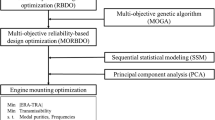Abstract
In this paper a methodologyto improve the development of mechanical components during thefirst design phase is proposed. This phase is one of the mostimportant ones in order to build up a product meeting with consumers'approval. The approach is based on a preliminary geometric-structuralmodeling optimization of the component studied. This optimizationis of a multiobjective kind and it aims to obtain some meaningfulgoals to find feasible shapes of the component to design. Themaximization/minimization of the objective functions is performedby an evolutionary algorithm to accomplish a constrained optimizationusing discrete variables. The characteristics of the methodologyare pointed out in relation to the properties of the evolutionaryalgorithm implemented. The paper concludes with an applicationexample of the procedure. The case study is a car gearbox. Threeobjectives are simultaneously pursued: the lowest weight, thegreatest flexural and torsional stiffnesses.
Similar content being viewed by others
References
G. Molina, “Simultaneous car design,” Research Center Fiat/Teskid, Aluminum Division, Proceedings of CAD Industrial Design Methodologies Course, CISM, Udine, Italy, 1996.
L. D. Albano and N. P. Suh, “Axiomatic design and concurrent engineering.” Computer-Aided Design 26(7), pp. 499–504, 1994.
D. A. Marca, IDEF0/SADT Business Process and Enterprise Modeling. Ecliptic Solutions Corp.: San Diego, USA, 1993.
S. C. Hill and A. R. Lee, A Concise Guide to the IDEF0 Technique: A Practical Technique for Business Process Reengineering, Enterprise. Technology Press Concepts: Puyallup, USA, 1995.
Z. Michalewicz, Genetic Algorithms + Data Structures = Evolution Programs. Springer: Berlin, Germany, 1996.
T. Bäck, Evolutionary Algorithms in Theory and Practice. Oxford University Press: USA, 1996.
L. Chambres, Practical Handbook of Genetic Algorithms, Vol. 1, 2. CRC Press: USA, 1995.
D. Quagliarella et al. (eds.), Genetic Algorithms and Evolution Strategies in Engineering and Computer Science. John Wiley & Sons: New York, 1998.
K. Miettinen, et al. (eds.), Evolutionary Algorithms in Engineering and Computer Science. John Wiley & Sons: New York, 1999.
K. Miettinen, et al. (eds.), Proceedings of EUROGEN99–Short Course on Evolutionary Algorithms in Engineering and Computer Science, Jyväskylä, Finland, 1999.
Rossi S.p.A Parallel and Right Angle Shaft Gear Reducers and Gearmotors Catalogue. Italy, 1998.
W. H. Press, et al., Numerical Recipes. Cambridge University Press: USA, 1992.
NAG Fortran Library Routine Document, Mark17, 1997.
Eureka Gold 8.0 Handbooks, CadLab S.p.A, Casalecchio di Reno, Bologna, Italy, 1997.
J. L. Ringuest, Multiobjective Optimization: Behavioural and Computational Consideration. Kluwer Academic Publisher: London, 1992.
R. E. Steuer, Multiple Criteria Optimization: Theory, Computation and Application. John Wiley & Sons: USA, 1985.
G. Mitsuo and C. Runwei, Genetic Algorithms and Engineering Design. John Wiley & Sons: USA, 1997.
J. Ignizio, Linear Programming in Single & Multiple-Objective System. Prentice Hall: Englewood Cliffs, NJ, 1982.
J. Cohon, Multiobjective Programming and Planning. Academic Press: New York, 1978.
H. Dubbel, Handbook of Mechanical Engineering. Springer-Verlag: London, 1994.
W. Flügge, Handbook of Engineering Mechanics. McGraw-Hill Book Company: New York, USA, 1962.
D. T. Pham, Artificial Intelligence in Design. Springer-Verlag: London, 1991.
Author information
Authors and Affiliations
Rights and permissions
About this article
Cite this article
Muscia, R., Sedmak, O. Preliminary Optimal Geometric Modeling of Mechanical Components: A Multiobjective Approach. Journal of Systems Integration 10, 23–39 (2000). https://doi.org/10.1023/A:1026555200788
Issue Date:
DOI: https://doi.org/10.1023/A:1026555200788




